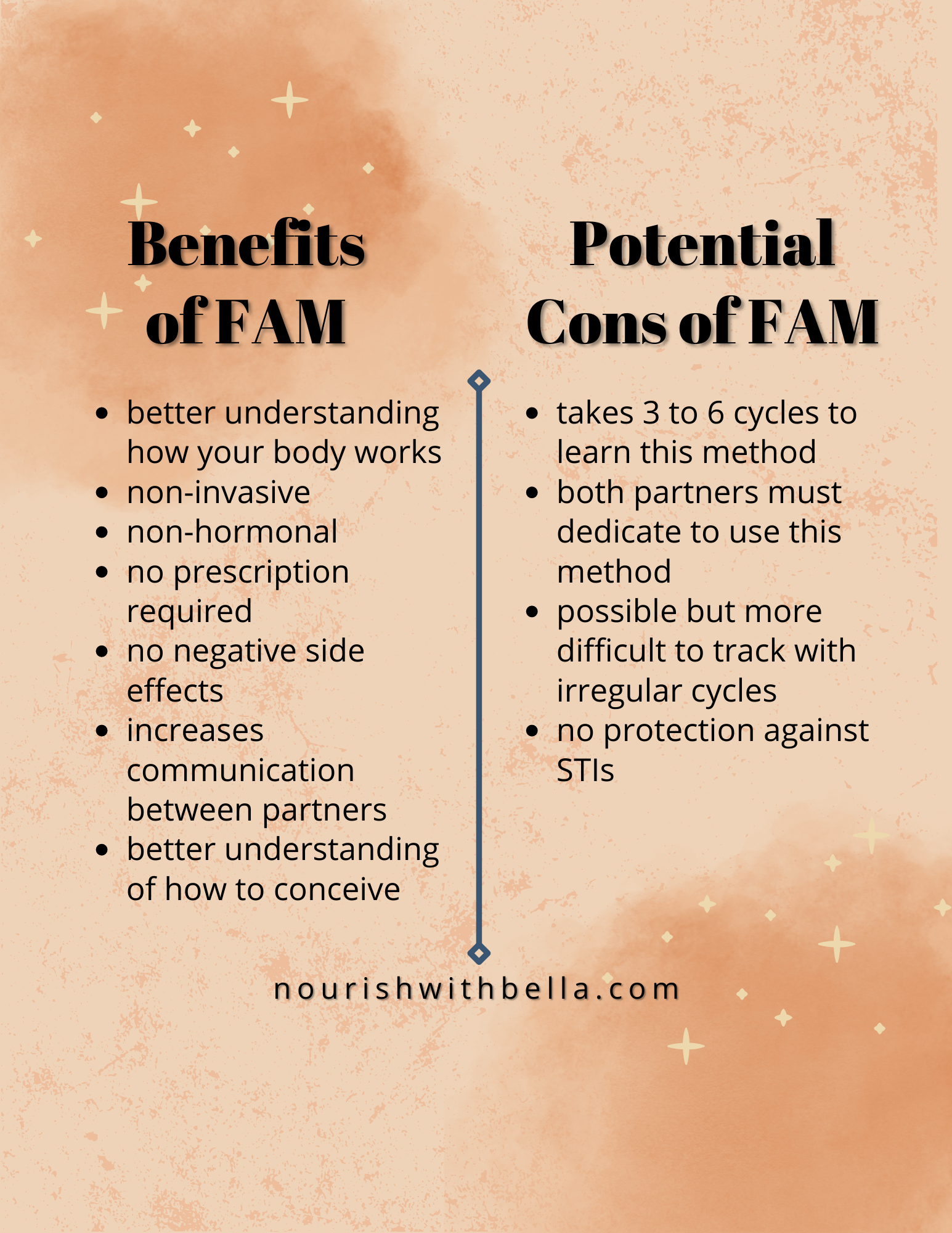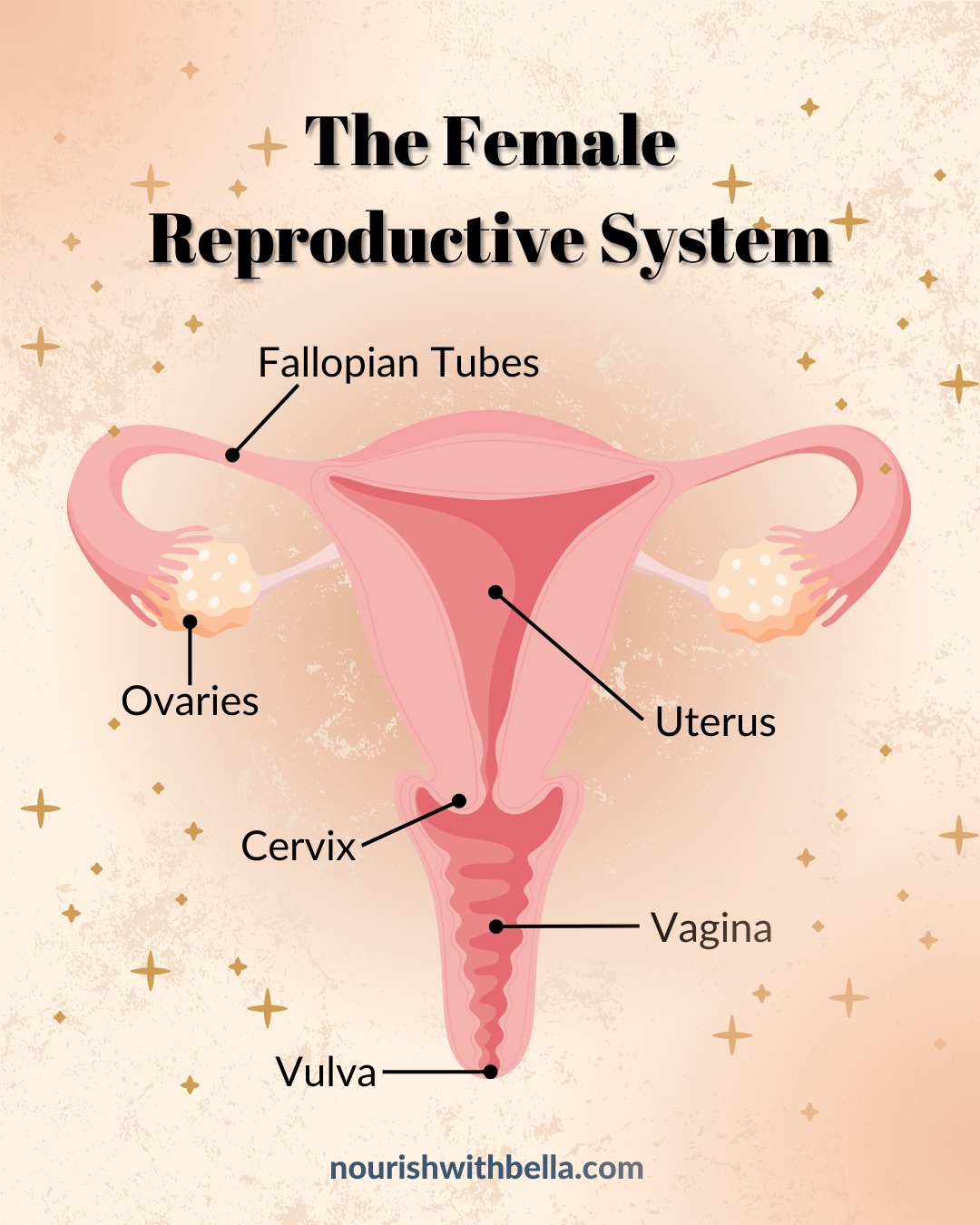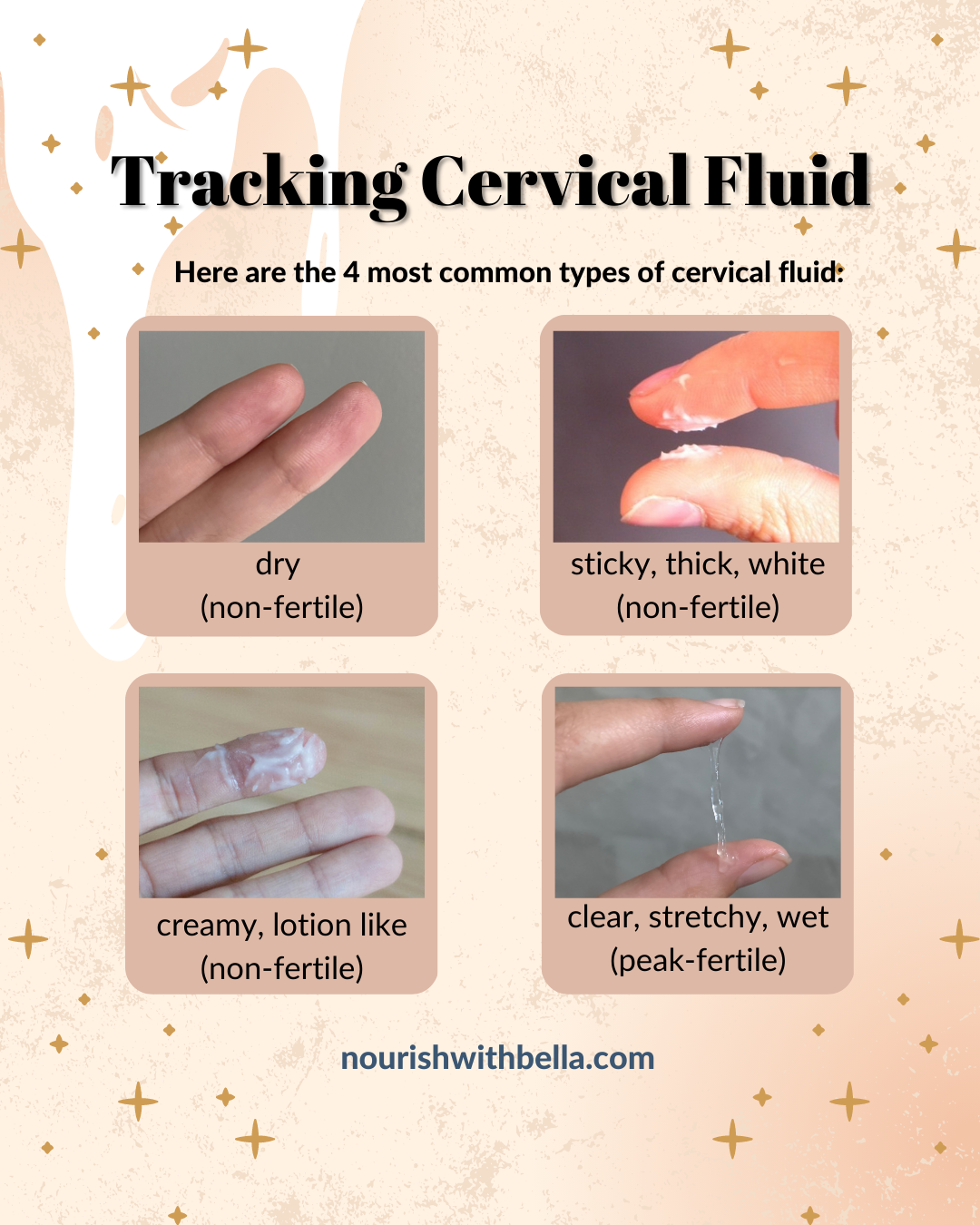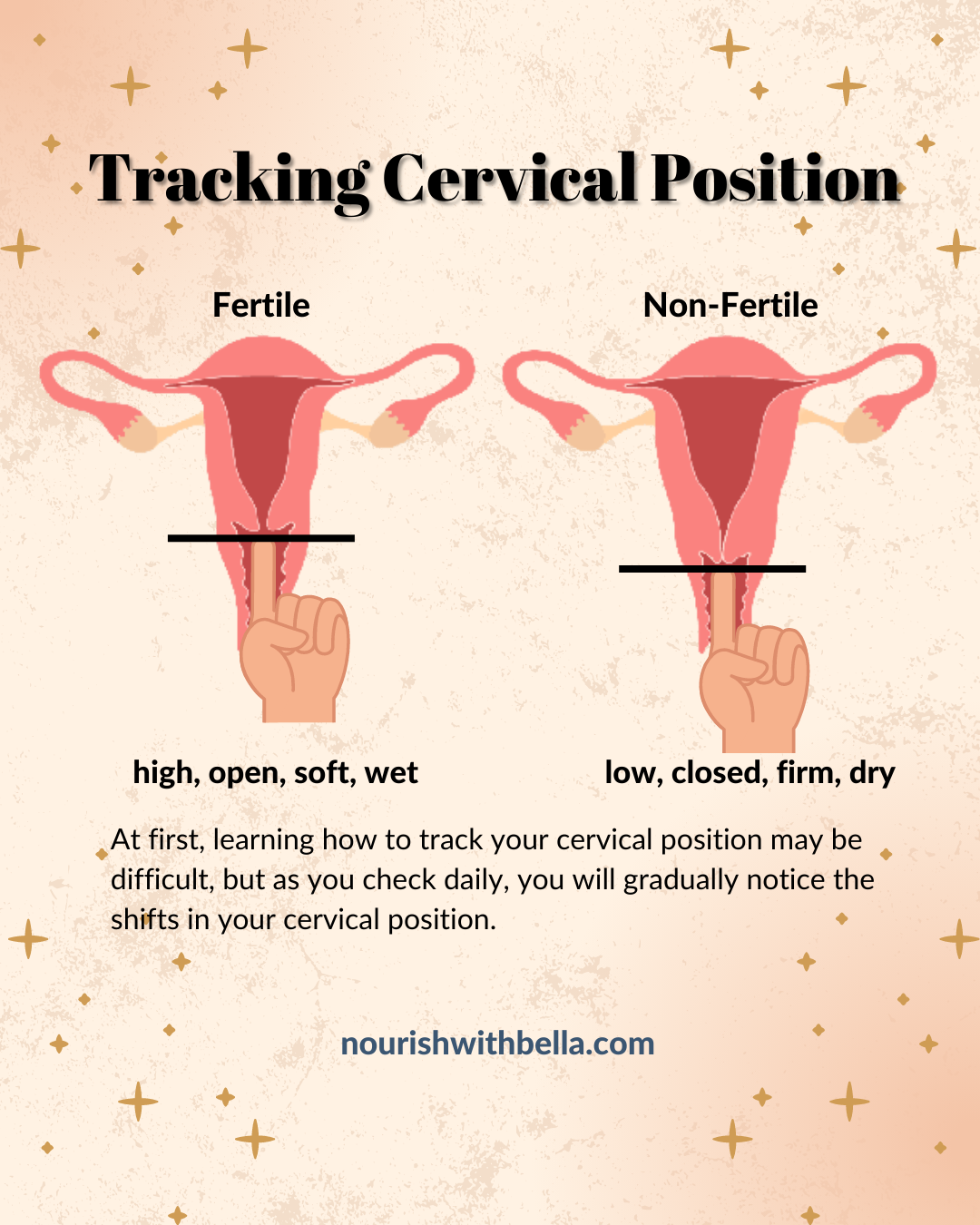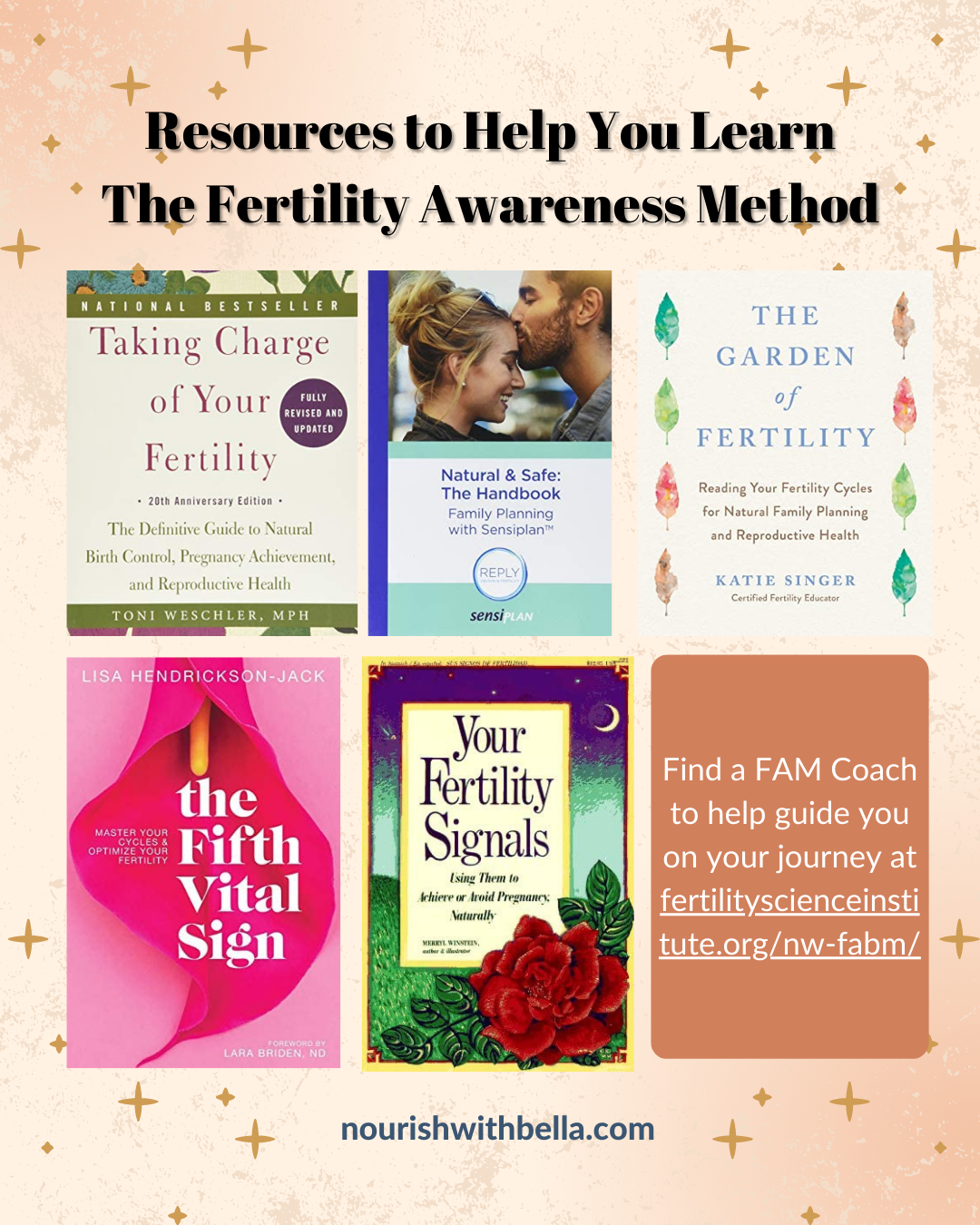The Fertility Awareness Method (FAM) - A Natural Form of Birth Control
What if I confidently assured you that you definitely don’t need hormonal contraception to avoid pregnancy and that you’re only fertile for six days throughout your monthly cycle? Our incredible female body gives us clear daily signs to show when we are fertile and when we are not. By understanding these signs, we can either avoid getting pregnant or improve our chances of becoming pregnant. We do this through applying the Fertility Awareness Method (FAM).
This blog post explains the Fertility Awareness Method: the process, benefits, drawbacks, and practice of this mindful, natural form of birth control. If you want an in-depth guide on how to use the Fertility Awareness Method as your form of birth control, I highly recommend hiring a FAM coach or read additional information I mention at the end of this blog.
*All of the following information is for educational purposes only. If you want to use FAM as your primary form of birth control, hire a FAM coach or do you own additional research.*
What Is the Fertility Awareness Method (FAM)?
The purpose of FAM is to make you much more aware of your own fertility, recognizing when you are fertile during your menstrual cycle. Throughout your monthly menstrual cycle, your body gives you many signs that help you pinpoint ovulation. Ovulation is the phase in the menstrual cycle when your ovary releases an egg and can potentially become fertilized resulting in a pregnancy.
The Fertility Awareness Method is the combined daily habit of taking and charting your basal body temperature, cervical fluid, and cervical position to determine the days you have a high or low chance of getting pregnant. FAM is also referred to as the sympto-thermal method of birth control because you use body temperature and other bodily signs to determine your time of ovulation.
It’s also important to note that FAM is not the same method as the rhythm method or calendar method. The rhythm method only tracks certain days of the menstrual cycle to predict ovulation. While FAM identifies and confirms ovulation through self analysis and daily observation of basal body temperature, cervical fluid, and cervical position. The rhythm method is not nearly as effective as the Fertility Awareness Method.
The beauty and benefit of FAM remain its tried-and-true way to avoid pregnancy as well as an outstanding way to ensure pregnancy.
Benefits of FAM
FAM promotes and provides numerous benefits. Understanding and using FAM not only relates to fertility but also your overall health. Benefits include how to …
better understand how your female body works
identify when you have a high chance of getting pregnant
identify when you have a low chance of getting pregnant
identify possible abnormalities in your cycle
track certain health conditions, such as polycystic ovarian syndrome (PCOS)
determine your typical menstrual cycle duration
feel more at ease when your period comes
use a non-invasive form of birth control
never have to get a synthetic hormonal birth control prescription
experience no negative side effects, unlike hormonal birth control
increase communication with your sex partner(s)
enjoy FAM’s effectiveness, 99% effective when performed correctly
Potential Drawbacks of FAM
Some potential drawbacks of FAM exist, including…
requiring three to six months to learn FAM
requiring committed partners, dedicated to learning and using this method
challenging to track irregular cycles, yet still possible
not protecting against sexually transmitted infections (STIs)
Female Reproductive System
Before we discuss the three major components of FAM, we need to understand the anatomy of the female reproductive system.
Vulva: The vulva is often confused with the vagina. The vulva consists of the external female sex organs, including the mons pubis (pubic hair area), labia majora (outer lips), labia minora (inner lips), and the clitoris. Vulvas normally come in a variety of beautiful colors and shapes.
Vagina: The vagina is the tube that connects the vulva to the cervix and uterus. This is the birth canal where menstrual blood and babies leave the uterus, as well as the flexible, muscular tract where penises, fingers, or tampons are inserted.
Cervix: Rounded with a small hole in the middle, the cervix divides the vagina and the uterus. The cervix opens and changes throughout your menstrual cycle. Menstrual blood flows out of the cervix from the uterus to the vagina during your period and allows sperm to enter the uterus during sex.
Uterus: The uterus is a pear-shaped organ, also called the womb, where an embryo and fetus grow during pregnancy. The lining of the uterus thickens during the follicular phase to nest the egg for potential fertilization. If the egg is not fertilized, the uterine lining sheds during the following period.
Fallopian Tubes: The fallopian tubes are two narrow oviducts that connect the ovaries to the uterus. They carry the egg from the ovaries to the uterus, while also allowing sperm to travel through for potential fertilization.
Ovaries: The two ovaries are located at the end of the fallopian tubes. The ovaries store eggs while also producing hormones like estrogen and progesterone. Typically, the ovaries take turns releasing an egg during each menstrual cycle.
Now that we have a better understanding of the female reproductive system and the anatomical jargon, let's discuss how to perform the Fertility Awareness Method.
How to Chart Using FAM
As mentioned above, FAM typically uses three fertility signs to help you determine which day of your cycle you are most likely to ovulate:
basal body temperature (waking temperature)
cervical fluid (cervical mucus)
cervical position
In order for FAM to be most effective, track all three of these fertility indicators. Other methods use just one or two of these signs, but I strongly recommend learning and using all three.
When it comes to charting, many apps are available:
Read Your Body (my personal favorite)
Flo
Clue
Ovia
Natural Cycles
Apple Health App
You can also use a simple pencil-and-paper chart to track your information. I use the one included in my online course, Restore Your Hormones, but you can find many free versions on the Internet.
Before we get into tracking FAM, we first must discuss why we cannot blindly trust period apps predictions as a form of birth control.
Why Period Apps are Inaccurate
A period app CANNOT accurately predict when you’ll ovulate or when you’ll get your period. Only YOU can do that by tracking your daily fertility signs.
The way period apps “track” ovulation and your period is through an algorithm. These algorithms are often based on a typical 28 day cycle or data from your previous cycles. However, most women’s cycles vary from 21-35 days. Plus, there are many lifestyle factors that can alter your exact ovulation date which is the main reason why we cannot blindingly trust these period apps.
Period apps dont know...
if you’ve had a stressful week
your true fertile window
when/if you ovulate
if your cycle is irregular
the length of your luteal phase
when your period will come
if you have a certain medical condition like PCOS
if you’re taking medications
The best way to ACTUALLY predict ovulation and when you’ll period will come is by tracking your fertility signs: basal body temperature, cervical fluid, & cervical position.
So instead of trusting these often inaccurate period apps, let’s learn how to implement the Fertility Awareness Method to actually predict and confirm ovulation and either improve your chances or pregnancy or successfully avoid pregnancy.
What Equipment Do I Need for FAM?
The only instrument you need to practice FAM is a basal body thermometer. This type of thermometer tracks two decimals, making the temperature reading much more accurate.
Personally, I use a basic basal body thermometer, like this one. But, you can also use more high tech thermometers that sync with your phone, such as Tempdrop or Daysy.
Tracking Basal Body Temperature (BBT)
First, what is your basal body temperature and when is it recorded?
Your basal body temperature is the lowest body temperature throughout the day, when you’re fully at rest. Always record your basal body temperature immediately upon waking, even before getting out of bed.
How to Take Your Basal Body Temperature
Ideally, take your temperature at the exact same time each morning. Keep your basal body thermometer near your bed. Take your temperature immediately upon waking and record your results.
How to Analyze Your Temperatures.
The purpose of tracking your temperature helps you identify the two phases of your cycle: the follicular phase and the luteal phase. The follicular phase starts on the first day of your period and ends once you ovulate. During the follicular phase, your follicle in your ovary develops in order to release an egg. The process of releasing the egg is called ovulation. During the follicular phase, your BBT will be relatively low. Usually temps in the follicular phase range from 97°F to 97.6°F (36.1°C - 36.5°C). Once you ovulate, you will notice a shift in temperature within one or two days. The temp shift helps you confirm ovulation. A temp shift must be 0.2°F above the previous six days of recorded temps in order to be considered a valid shift.
Your temp shift marks the beginning of your luteal phase, the second half of your cycle. During this phase, your basal body temperature elevates above the previous temps in your follicular phase. The average temps in the luteal phase range from 97.6°F (36.5°C) or higher. After your temp shift, you should have two more days of high temperature. This temp shift of three days straight confirms that ovulation has occurred and that you're no longer fertile. You can freely have unprotected sex at this point without getting pregnant.
As your cycle comes to an end, you see a drastic drop in temperature. This drop indicates your period should come within a day or two.
Factors That Can Compromise Your Temps
There are certain factors that can alter your daily waking temperature, including…
drinking alcohol the night before
having a fever
getting less than three hours of consecutive sleep
taking the reading at a different time than usual
using a heated blanket when you normally don't
Even with altering factors, don’t worry about erratic temps if you track the other two daily signs, cervical fluid and cervical position. A few erratic temperatures do not compromise the accuracy of this method of birth control.
Tracking Cervical Fluid
Tracking cervical fluid adds another essential component of FAM. In my personal experience successfully using this method, tracking cervical fluid remains the most important fertility sign because it changes with one’s hormones in real time. When tracking temperature, you can only confirm ovulation after occurring. Whereas clearly tracking cervical fluid, you can identify ovulation when it happens. Some women solely use the cervical mucus method, also called the Billings Ovulation Method, by tracking cervical fluid and nothing else. However, if you're just getting started, I highly recommend tracking all three fertility signs of BBT, cervical fluid, and cervical position.
What Is Cervical Fluid?
Cervical fluid is produced by and released from the cervix. Cervical fluid consistency changes throughout the cycle. Understanding your cervical fluid changes helps you better identify when you are most and least fertile. Fertile cervical fluid to women rivals seminal fluid to men. Since men are always fertile, they produce semen every day. However, women become fertile only six days within their cycles. At this time, women produce fertile cervical fluid, necessary for sperm protection, nourishment, and mobility only right before and during ovulation.
How to Identify the Different Types of Cervical Fluid
Four different types of cervical fluid include …
dry (non-fertile)
sticky, thick, white (non-fertile)
creamy, white, lotion-like (non-fertile)
clear, wet, stretchy, slippery, raw-egg-white-like (peak-fertile)
Right after your period, your cervical fluid typically dries for a few days and then transitions to become white, thick, and sticky. As more days pass, your cervical fluid becomes less thick and more creamy, lotion-like. As you approach ovulation, cervical fluid becomes thinner, clear, slippery, and stretchy, resembling a raw-egg-white consistency. This raw-egg-white-like cervical fluid consistency indicates that ovulation is approaching and you are in your fertile window. After ovulation, your cervical fluid dries up and returns to a non-fertile, thick, white, or dry state, unable to become impregnated.
The exact pattern of cervical fluid transition differs for every woman. Your pattern may not look exactly like the one exemplified above. Understanding how to identify the consistency of your cervical fluid and tracking changes are keys to understanding your fertility and managing your sex life.
How to Track Cervical Fluid
Check your cervical fluid daily, each time you use the bathroom since cervical fluid can change throughout the day. To check your fluid, take a clean finger or two and swipe your vulva before peeing. Inspect the consistency and note which type of fluid it most resembles. This process can be strange while learning but becomes more natural and easier to identify with time and practice.
Tracking Cervical Position
Along with BBT and cervical fluid, tracking cervical position is the third essential sign to identify fertility. Throughout your cycle, the cervix shifts: high, low, open, closed, soft, and firm. Tracking these changes in your cervix helps you identify when you are fertile or not.
The cervix is the glorious gateway between the uterus and vagina. During your fertile days, the cervix becomes soft, high, open, and wet. This shift allows sperm to enter the uterus and fallopian tubes for potential egg fertilization. During your non-fertile days, the cervix becomes firm, low, closed, and dry.
In simple terms…
high, soft, open, wet cervix indicates fertile.
low, firm, closed, dry cervix indicates non-fertile.
How to Track Your Cervical Position
Begin by checking your cervical fluid at least one day after your period ends.
Make sure your fingernails are trimmed and your hands are clean.
Aim to check your cervix around the same time each day.
Squat when checking, by far the most effective way to check, analyze, and evaluate.
Insert your middle finger into your vagina and judge whether your cervix is soft or firm, high or low, open or closed, wet or dry.
Important to note that women who vaginally delivered children always have a slightly opened cervix. Also, if you have a vaginal infection or genital sores, you should not check your cervix.
At first, learning how to track your cervical position may be difficult, but as you check daily, you gradually notice your cervical position shifts from soft to firm, high to low, open to closed, wet to dry.
How to Implement FAM as Your Primary Form of Birth Control
Before you start using the Fertility Awareness Method as your primary form of birth control, I recommend learning and practicing for at least three to six months. Once you have a better understanding of this method and feel more comfortable, you can then use it as your primary method. In the meantime, you can read Non-Hormonal Forms of Birth Control to learn more about other possible birth control options.
Additional Resources to Help You Learn More About FAM
This blog raises awareness about FAM and helps you get started using this effective birth-control method. Personally, I am self-taught through reading numerous books and articles on how to effectively use FAM. My commitment to learning and using FAM have worked perfectly for the past four years. Here are some books I recommend to enhance your knowledge and learn how to implement FAM into your daily practice.
Sensiplan Natural & Safe: The Handbook by Reply Ob/Gyn & Fertility
The Fifth Vital Sign: Master Your Cycles & Optimize Your Fertility by Lisa Hendrickson-Jack
Your Fertility Signals: Using Them to Achieve or Avoid Pregnancy Naturally by Merryl Winstein
You can become self-taught too, but many interested in using FAM, choose to hire a coach. Below is a website on how to find a FAM coach to help you learn how to better understand and effectively implement FAM as your personal form of birth control.
Find a FAM coach - https://fertilityscienceinstitute.org/nw-fabm/
If you have any questions about the Fertility Awareness Method, please ask by commenting below or send me an email at bella@nourishwithbella.com



